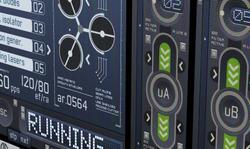 GUIs, ZUIs, and all the WIMPs in between, interfaces of the present don't meet the expectations of movies from the past. In 2006, a column by Nielsen outlined the top ten "bloopers" of using fictional interfaces in film. Highlights include "You've Got Mail is Always Good News" and "Access Denied / Access Granted". Visual designers such as Mark Coleran are responsible for what appears on the shiny computer screens for the big screen. 2007 certainly was no stranger to the foreign interfaces of the future. Ocean's 13 saw a text field with no buttons, where the user would be forced to type everything out without even the slightest usage of txtshorthand (e.g. "search for a good movie" or "zoom in to photo"). Hopefully, the interfaces of fiction don't have an IRL future.
GUIs, ZUIs, and all the WIMPs in between, interfaces of the present don't meet the expectations of movies from the past. In 2006, a column by Nielsen outlined the top ten "bloopers" of using fictional interfaces in film. Highlights include "You've Got Mail is Always Good News" and "Access Denied / Access Granted". Visual designers such as Mark Coleran are responsible for what appears on the shiny computer screens for the big screen. 2007 certainly was no stranger to the foreign interfaces of the future. Ocean's 13 saw a text field with no buttons, where the user would be forced to type everything out without even the slightest usage of txtshorthand (e.g. "search for a good movie" or "zoom in to photo"). Hopefully, the interfaces of fiction don't have an IRL future.

Search

Categories
Archives
- November 2008
- August 2008
- July 2008
- June 2008
- May 2008
- April 2008
- March 2008
- February 2008
- January 2008
- December 2007
- November 2007
- October 2007
- September 2007
- August 2007
- July 2007
- June 2007
- May 2007
- April 2007
- March 2007
- February 2007
- January 2007
- December 2006
- November 2006
- October 2006
- September 2006
- August 2006
a nod and a wink
Powered by
Movable Type Open Source 4.1
Movable Type Open Source 4.1


And let's not forget Alien, where the UI for interfacing with Mother (the ship's AI) consisted of a single keyboarded terminal locked away in one of the most distant parts of the ship, far away from the main quarters and the bridge.
I don't know if Jakob Nielsen has any kids. If he does, however, I hope his wife takes care of story time, because he just doesn't get it. The purpose of any interface in a film is not to be usable. The purpose, rather -- like the purpose of any set, costume, or line of dialogue -- is to advance the story. Do I care if Jack Bauer has any network hiccups accessing data? Not when getting that data is critical to the story. And if it takes the 12 year old in Jurassic Park 10 minutes to pore over man pages, that's fine -- but I don't need to see it. Not only are some of his points missing the point (of entertainment, that is) but mid-way through he changes his argument not to dismiss the implausible but to be jealous -- his argument about big fonts changes from "this wouldn't work in a real world interface" to "this would improve real world interfaces and I'm pissed I don't have it." Finally, some of his assertions are flat-out wrong; he criticizes "joysticks and touchpads" as being suboptimal interfaces, when in fact joysticks are used on fighter jets (which travel much more quickly and in an additional vector than cars). I'm not going to claim hollywood doesn't deserve an arrest warrant from the reality police, but my key takeaway from this article is that Jakob Nielsen is an angry old luddite.
If usabilty engineers ruled the web, what a boring place it would be. Reminds me of the current fad of trying to get a high score on a Forrester review: nice work...too bad your site has the entertainment value of a Sears catalog.
Perhaps it'd be worth mentioning that occasionally filmmakers are tech-savvy enough to put realistic interfaces into their films; in The Matrix Reloaded, Trinity uses nmap from the command line to hack into the systems of a power plant.
Better yet, it's done in an entirely subtle and discreet fashion; the audience knows she's hacking the system and that's all that's important, but for the more observant viewer, she's using a real contemporary tool to do it.